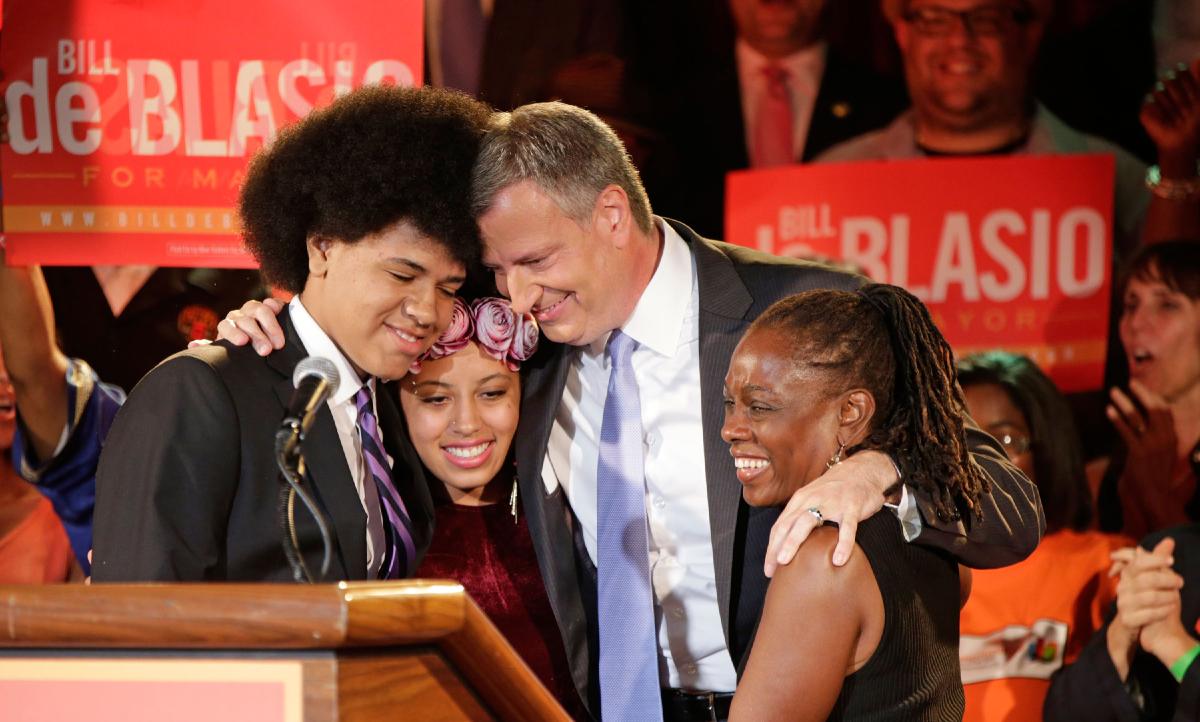(Source: AP via New York)
That story heralded a new, but now two-decade-old, era of top-down, high-capitalist, urban governance, emphasizing disciplined municipal management over identity politics and federal aid. Now that kind of governance is being challenged by elections such as the one on Tuesday that will give New York’s City Hall to left-liberal Democrat Bill de Blasio after five terms of Giuliani and his successor Michael Bloomberg.
| Bill De Blasio has had ample opportunity to learn the “good” lessons of Rudy Giuliani and Michael Bloomberg’s governance and to sift out the bad. |
Now The New Republic has Michael Schaffer’s perceptive piece on how De Blasio’s election marks the end of the era whose beginning was marked by the “End of the Rainbow?” essay in 1993.
This is not a swing of the pendulum back to the “Rainbow” years. More likely, it’s a step up a steep learning curve of municipal governance, a step as necessary as the one in 1993 when voters in New York but also in Chicago, Philadelphia, Los Angeles and other cities replaced “Rainbow” mayors (most of them black) with centrist, “managerial” types like Giuliani, most of them white—even as those electorates became less white, not more.
Some such shift in governing philosophy and strategy was overdue. Municipal politics had to transcend or at least temper the ethno-racial “identity politics” that had produced more division than inclusion in the endless scramble for municipal jobs and programs. “Rainbow” politics had intensified over-reliance on federally funded social-welfare policies by highly self-interested constituencies, including demagogic racialist protest groups and less-than-noble municipal unions, that made their livings off of patronage precisely as white ethno-racial groups had always done.
These complicated problems can prompt different but equally credible political positions. I’ve written about them at length and won’t reprise them here.
But I do want to emphasize that although the new, centrist mayors of the 1990s were right to insist on more managerial approaches, they embraced too uncritically—indeed, kowtowed to—even-more powerful, self-interested constituencies that were riding and channeling the riptides of an increasingly casino-financed (literally and figuratively), crony “corporate-welfarist,” consumer-degrading political economy.
The “managerial” mayors of the 1990s and early 2000s whose municipalities rode those riptides with tighter rigging and more-disciplined crews have done much good, strategically. But the riptides themselves have become destructive of social stability and civic dignity. The old “Rainbow” mayors’ discredited practice of bending over backwards to placate poverticians and promoters of a racial “riot ideology” has been replaced by more recent mayors’ “top-down” pandering to brokers and predators whose own riots have thrown millions of Americans out of their homes and jobs.
Throughout the 1990s, I argued—and still insist, and have the body scars to show for it—that liberal governments must work closely with constituencies that hold even their poorest members to the same elementary social standards and work ethic that most people demand of their own children.
But that discipline must come from below along with credible opportunity from above, and what’s coming from above now in our casino-financed, consumer-groping, crony-capitalist regime is degrading. It’s because conservatives such as those at the Manhattan Institute think tank cannot acknowledge this that they’re losing.
Conservatives cannot reconcile their creditable calls for ordered, republican liberty with their knee-jerk obeisance, under the banner of “free markets,” to the global financing and marketing juggernaut that’s dissolving American republican virtue and even sovereignty before their very eyes.
By 2007, with the rise of the national-security state and the predatory economy, I argued that Giuliani should never be president, partly because his own megalomania would be more dangerous with more power, but even more so because lessons and methods that made tactical sense for cities would (and already have) become truly oppressive in national governance.
The answer isn’t to swing back to ethno-racial solidarities and Great Society social-welfare programs that factored out discipline, sometimes under banners of “group rights.” Like Obama—who two days before his election in 2008, went to Hawaii to pay a last visit to the white mother of his white mother—De Blasio has an interracial family, mooting the kind of racialism that dominated too much “Rainbow” politics and worse.
I wish that the recently departed Rep. Major Owens of Brooklyn, whom I wrote about here last week, and whose own family was and is interracial as De Blasio’s—but who, in his first House race in 1982, had to endure the taunts of a “blacker than thou” opponent’s accusation that “he talks black but sleeps white”—had lived to see De Blasio’s election in his own hometown.
As the city’s public advocate, De Blasio has also had ample opportunity to learn the “good” lessons of Giuliani/Bloomberg governance and to sift out the bad. Whether our national political economy will really give him much room to strike better balances between public engagement and private investment remains to be seen. He’ll have to climb a steep learning curve, not ride a pendulum swing back.
Jim Sleeper, a writer and teacher on American civic culture and politics and a lecturer in political science at Yale, is the author of The Closest of Strangers: Liberalism and the Politics of Race in New York and Liberal Racism.



0 Comments